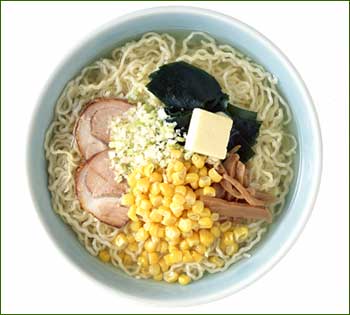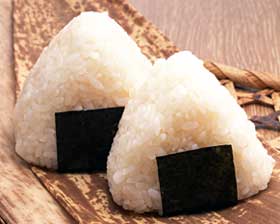
Two German guys are trying to eat their way through all sorts of "Asian style" noodles, and they are blogging their taste reviews (German site). I've tried some of the ones they've blogged so far though...and they are pretty bad.
Filed under:
japanese snack noodles

[Update:] Be sure to check out my easier, neater way to make onigiri!
Onigiri are rice balls, usually with a tasty filling. They are very portable, and therefore are very popular for carry-along lunches. Part of their appeal lies in the fact that if you're Japanese, you just love the taste of rice. It's genetic. [Edit: another word for onigiri is omusubi. I guess it just depends on what word you grew up with. In our house it was always onigiri.]
Onigiri can stand on their own, or be part of a bento or boxed lunch. (For some reason it's never just called "nigiri", though bento is also called obento, which is the honorific term.) Onigiri are also a great make-ahead snack for a crowd, since with the appropriate fillings they keep rather well. I remember my aunt making 12-cups of rice worth of onigiri at a time for the large family gatherings at New Year's or Obon (August festival to pay respect to our ancestors). Her hands would be bright red from the heat of the rice. She favored salted salmon (shio zake) as the filling usually - very salty salmon in fact.
Onigiri is also one of my top comfort foods. It reminds me of the ones my mother used to make for me for school outings (ensoku) as well as countless school lunches. When we stayed at my grandmother's and my cousines and I would take trips to the Chichibu mountain area, my aunt would make huge rice balls to assuage our appetites. There's a comforting feeling of continuity with history too, because Japanese travelers have sustained themselves on those salty rice balls for hundreds of years.
Like obento boxed lunches, onigiri can be elaborate creations, but the simple versions the are best in my opinion. We often bring some onigiri with us on long train trips: it's a lot better than buying the overpriced sandwich buns from the vending carts. Yes, sometimes people look at us curiously as we bite into those soccer-ball colored balls. We don't care one bit.
While I was working on writing up this entry, I came across this post by Mimi Ito . Japanese people have a lot of emotional attachment to obento, and to onigiri too.
Filed under:
basics japanese rice onigiri omusubi
One of the regular features I'll be putting here are some basics of Japanese cooking...since that's what I am (Japanese). Believe me, it's not as hard as you might think it is.
Filed under:
basics japanese dashi stock
Fall is the season for wild mushrooms. We can get mushrooms all year round now of course, but the wild variety are at their best when the fungi can draw lots of nice nutrients from the rotting leaves and wood that is lying around.
Fungi are a strange thing. They feast on decay. All plant material draw energy to grow from their decayed ancestors, but fungi are the only things that draw all of their energy from this source. And, the more they can suck up, the more flavorful they seem to be.
Truffles for instance, are so greedy that they don't even raise their heads out of the earth, until their are sniffed out by pigs or dogs. (Allegedly, virgins can also detect truffles.) I was quite sceptical about the reputation enjoyed by the truffle, until the day I actually had one, a real one, not just truffle oil or the microscopic specks of truffle that are allegedly in some canned patés. This was a real truffle, sliced into bold chunks and baked inside a dish modestly called a galette de pommes (potato cake) on the menu of the Beurehiesel in Stransbourg. (The Buerehiesel is a 3-star Michelin establishment, and our favorite restaurant right now. It will be mentioned many times in this blog I'm sure.) The wonderful fragrance of the truffle permeated the potato cake and made it something out of this world.
While we can't afford truffles on a regular basis, we can enjoy wild mushrooms. One of our favorite ways of enjoying a delightfully smelly bag of mixed fungi is simply cooked in our trusty rice cooker with a basic dashi stock. It can be assembled in no time, and then you just wait for your kitchen to be filled with the fragrance of the 'shrooms. It's low-fat too.
Filed under:
japanese rice mushrooms fall